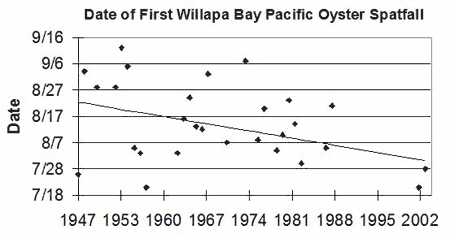|
In 2002, we re-initiated weekly shellstrings that WDFW discontinued in the 1980s due to funding constraints. The record from the 1930s to 1980s, however, is an amazing time series to ask how natural recruitment of both native and Pacific oysters has changed. For many decades, scientists studied these records, as well as weather and water temperature reports, to try to develop an effective forecasting equation to predict spatfall. These efforts largely failed, being overwhelmed by idiosyncracies of particular places and times. We can’t possibly expect to do any better, so spatfall prediction is not our goal. Many growers have told us, however, that Pacifics are spawning at lower temperatures each decade, and that spatfall is more reliable now than it has been in the past. We can now address these questions quantitatively, and results may also have important implications for global climate change and adaptation of introduced species to new locations.
|



